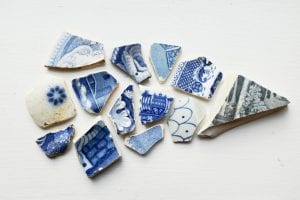Repair? Restoration? Renewal?
The Art of Mending Broken Ceramic
By Ji-Hyun Lee
About ten years ago, I broke my favorite celadon mug. It was a grayish celadon with black natural specs and cherry blossoms sprays in white slip. It was the first mug I ever purchased for myself, one of few in the market with the perfect grip in my hand, and a part of my memories of my graduate studies in London. I texted one of the conservators in the museum I used to work for, purchased the recommended synthetic glue, and assembled the shards back into shape. I soon regretted that I will never be able to drink from it but use it as a pen pot. The shape may have been restored, but its function was not.
High-fired ceramic such as stoneware and porcelain is a material of paradoxical value. It is precious material composed of clay and ashes, transformed in the heat of 1,200 degrees Celsius to watertight, heat-resistant, and chemically stable material of semi-permanent life-span. But once it breaks, the loss of its original shape and function is irreversible that, in most cases, you just have to throw it away.
A ceramic vessel could be a utilitarian commodity on one hand, but depending on the value added by the artistic quality or political and historical context of the object, a crude-looking tea bowl or a chipped caddie could be worth an exchange with a fortress, as a Japanese warlord Oda Nobunaga did in 1580, giving out a gift of a tea caddie and a miniature stone in exchange of Ishiyama fortress, Osaka. Even without such political significance, an ordinary looking bowl, or an ugly tile painting at home could be an irreplaceable piece of memory, to the eyes of an individual beholder.
Before the use of synthetic glues, the most common methods of mending ceramic in East Asia were riveting and lacquer-binding methods. In China, a seventeenth-century agricultural treatises Nong Zheng Quan Shu (in Chinese) by Xu Guang-qi mentions couple recipes using lime mixed with egg-white, or starch-glue made of baiji orchid rhizome. Using such quicklime cement was few of the applicable material to put together broken ceramic, however, its strength would not stand the everyday stress of physical impact (break) and temperature changes (tick) in serving hot food and dish-washing. (water sounds) By the eighteenth century, the menders began to reinforce the cement repair by using metal rivets shaped like staples, (drilling sound) which were fit into pairs of holes drilled along the mended cracks to fix the pieces together. Although the practice has become obsolete, few surviving repairers are still active in China today. This mechanical type of repair may not be aesthetically pleasing, but overall restored the vessel’s watertight function and strength.
Using lacquer paste to bind ceramic has been more commonly used technique in Japan by a highly skilled hands. Because each lacquer tree yields only a dab of sap and the sap solidifies in contact with humid air instead of evaporation, the process is costly and laborious. The lacquer paste work as both the adhesive binder and infills for lacunae, but each coat should be thinly applied in multiple layers in a dust-free room with controlled room temperature and humidity that it will take more steps and layers for infilling larger gaps. Once the repair is finished, the lacquered crack marks may be finished with gold, for which the technique was named kintsugi. (gas flow) Fully solidified lacquer becomes resistant to heat, water, and other causes of chemical degradation unless exposed to strong ultraviolet ray. The repaired ceramic can be used again in its full function to hold food and water, and the kintsugi marks become a part of the history of the ceramic piece.
Since antique ceramics has come to be appreciated more and more as art of great aesthetic and historical value, the kintsugi repair technique, sometimes modified to use synthetic epoxy or other types of natural resin, has spread to China, US and other parts of the world not just as repair but as art of creating a new aesthetic value of the damaged piece.
In museum conservation, however, the approach is slightly different. The ceramic objects are treated as artifact, an embodiment of history that should be preserved in the closest condition to its original form, without presumptuous renovation on the missing parts. There are varieties of adhesive binder, material and methods used, but the point of any museum’s approach in repairing ceramic is to make it traceable, reversible, chemically stable, and physically enduring enough to hold together the pieces in even tension so the tension unbalance will not damage the original material in long term.
If a ceramic is broken and repaired, is it like damage and repair? Or death and resurrection?
Siga’s Moon Jar, now housed in the Osaka Museum of Oriental Ceramics, tosses an interesting anecdote regarding this question. Named after a novelist who presented it as a gift to Reverend Kaiun, who later became the 206th head of To-dai-ji, Kyoto, this eighteenth-century Korean porcelain jar with a globular body of over 40cm height and width was a treasured item in the Kannonin temple. In the summer of 1995, a robber broke in. Soon spotted and about to be caught, he smashed the jar on the ground. Over 300 pieces and granules from the jar was carefully retrieved and sent to Osaka. After two years of analysis in the Oriental Ceramic Museum, numerous requests to and rejections from expert repairers, and seven months of restoration process, the jar came back to its original look with no visible trace of repair but the subtly different tone along the repair marks. The jar became even more famous and treasured by audiences beyond the temple, although it would never hold again fermented food as it once did at the royal kitchen of the Korean palace.
